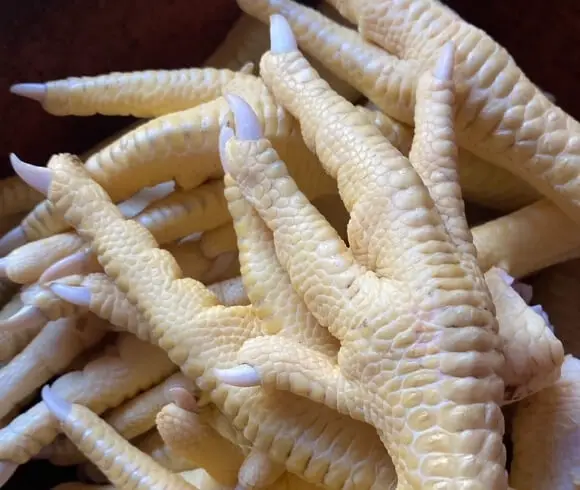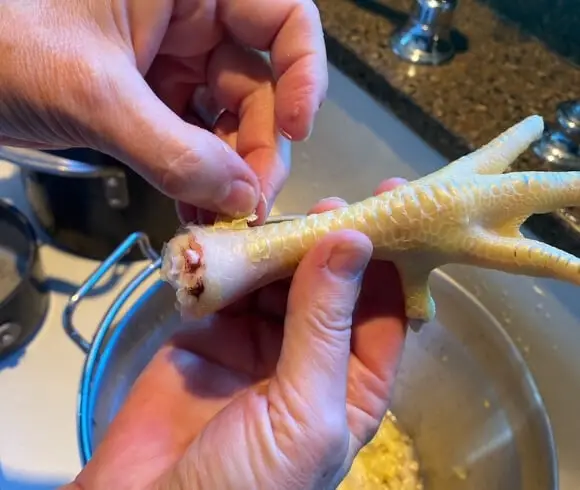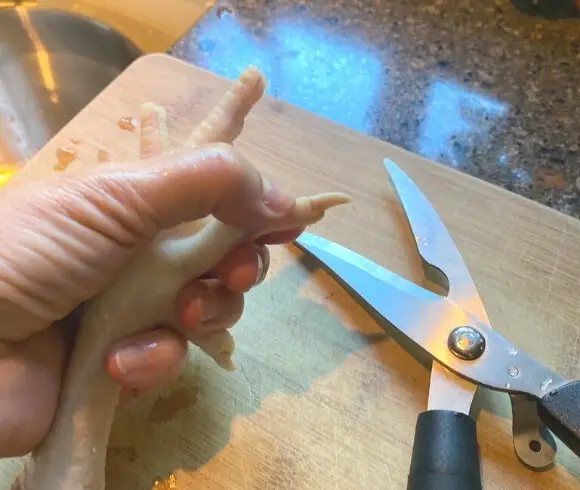Chicken feet. A topic not typically discussed, but one we can’t overlook here on the hill as we utilize a sustainable, no waste “head to tail” approach to our food. Cooks and chefs alike are learning to prepare and use chicken feet to their fullest potential, and for good reason.
This post may contain affiliate links at no additional cost to you. By making your purchases through the links on this website, IMSL may make a small percentage at no direct cost to you. IMSL only promotes products we use & truly believe in. Please refer to my Privacy & Disclosures for further information. IMSL thanks you for your support!
I know. It’s easy to become disgusted with the thought of utilizing chicken feet, aka chicken paws. After all, especially here in America, we have become a bit disconnected with our food. Sadly, it’s not unusual to sit down to a dinner that was created in a lab & highly processed, but will become grossed out with the thought of food in its most natural state.
I’ve heard it all in regard to the use of chicken feet. Ewwww is always a popular one 🙂 They may seem a bit disgusting, repulsive, & nauseating, but in reality they are useful, delicious, & filled with lots of vitamins, minerals, collagen and calcium. Everything our bodies need to maintain health.
BENEFITS OF USING CHICKEN FEET
So what benefits can you derive from utilizing the feet of chickens? Health. In a nutshell.
Our favorite way to utilize our prepared chicken feet is in the making of a highly nutritious bone broth. Making bone broth with the addition of a few prepared feet, will result in a wonderful, gelatinous broth.
Learning how to make bone broth may be one of the most economical, nutritious, and wholesome foods anyone can make in their own kitchen. Rich in nutrition and deep in flavor, bone broth has benefits far beyond creating the foundation for soups, stews, & sauces.
IMSL
Bone broth has become popular once again in both the professional kitchen and the homestead. And for good reason. Rich in protein, minerals, vitamins & amino acids, as well as magnesium, bone broth is healthy for you and your overall bodies health.
Homemade bone broth not only is a wonderful cup of morning sustenance, but makes for an amazing addition to recipes. Our Old Fashioned Chicken Soup recipe is always the recipient of our homemade broth.
And did we mention, chicken feet are extremely high in collagen, hyaluronic acid, & condroitin? Hello. Fountain of youth anyone? It seems Grandma did know best afterall 😉

SOURCING CHICKEN FEET
Unless you are blessed and can raise & process your own organic chickens, sourcing quality, safe chicken feet may take a little investigative work on your part. As with all my food sourcing recommendations here on the hill, organic is best.
That being said, chicken feet are not typically found on your meat grocer’s counter. That is unless you ask. Special ordering may be an option.
Talk with your local farmer/grower. See if you can reserve or pre-order the next time they will be dispatching.
Ethnic markets may be an option. Check yours for availability.
DO YOU PEEL CHICKEN FEET FOR STOCK OR BROTH
Yes, yes, & yes. But why go through the extra step to peel your chicken feet? In my humble opinion, simply for cleanliness. Think about what the chickens were walking in. Or better yet, simply look at the feet which have not been properly cleaned & processed.
There is, however, some discussion on whether it’s worth the added step to peel. Many don’t. Instead they simply scrub “clean” or even soak in a vinegar/water bath for 10+ minutes to clean.

Ultimately, the choice is yours. However, in my experience, no matter how involved the cleaning process, there is always a bit of unwanted elements left in the crevices and under the nails. Peeling the feet & removing the nails ensure a cleaner & ultimately safer end product in my opinion.
When sourcing your chicken feet, how do you determine if they have been peeled & prepared? The skin on a chicken foots skin is naturally yellow. If peeled the “meat” or muscle which is located under the skin is white. If they have been prepared already they may have the nails removed as well.
Or you can simply ask 😉
HOW TO PREPARE OR PEEL CHICKEN FEET
Should you decide you prefer watching how to peel the chicken feet once they have been blanched for 20 seconds, but no longer than 30 seconds, take a look at the short video I prepared below. Alternatively, you can follow the simple written instructions of preparing the chicken feet.
Note that this is a process. Often it can be a bit tedious especially when your processing 20-30 feet or more at a time. If you are butchering, I highly recommend you simply clean the feet, place in a container with a cover or a bag as shown below and refrigerate to process the following day.
Optionally, they can be frozen. To prepare & use, unthaw completely and follow the steps below.

STEP 1: SCALDING OR BLANCHING
Determining the length of time to scald or blanch the feet can be a tricky one. Too short a time, they don’t peel. Too long, yup, they don’t peel. Finding the “just right” timing is key to an easier removal process.
Fortunately, I have done that research & experimentation for you! I have found that working in small batches, meaning no more than 3-4 feet at a time, works best. Do too many at a time and the peeling becomes difficult if they sit too long after scalding.
In a pan with water at a rolling boil or a strong simmer, place 3-4 washed feet and scald for 20 seconds and absolutely no more than 30 seconds! Remove immediately with a spider or tongs and submerge in cold water briefly to stop the “cooking” process. The peeling process will be easier if the feet are left a bit warm to the touch.

STEP 2: PEEL
To begin the peeling process, I like to begin with the underside of the foot near the first joint and begin peeling toward the pad of the foot. The topside of the foot will be more “scaley” and sometimes more difficult to peel. I simply use my fingernail and remove all as I go taking, the time to reveal the pure white muscle (meat for lack of a better description) underneath.

STEP 3: REMOVE THE NAILS OR DECLAW
Once you have all the skin peeled away, you have several options for the nails or claws. You can either leave them as is (again, I don’t recommend this as unwanted feces & bacteria can remain) or remove them. It is also said that by having the chicken foot declawed leaves an opening for the collagen to release itself.
If you are strong enough, once the skin is peeled all the way to the toes and nail bed, you can simply pull the nail off. Or you can be like me and clip the end of the toe off with a pair of kitchen shears.

STEP 4: FREEZE PREPARED CHICKEN FEET
Once you have completed the removal of both the skin and the claws from the feet, place them all in a freezer bag together and freeze. I find this the easiest method for preserving them as I can easily remove the desired number from the bag to unthaw as needed.
USES FOR CHICKEN FEET
Should you not be looking to preserve your prepared chicken feet for futher use, there are many recipes, especially Asian recipes which use the feet, or you can make broths, and stocks which can then be added to most recipes calling for stock.
Our favorite use though? Chicken stock or broth.
CHICKEN FOOT STOCK
Making stock from chicken feet is easy to do. Know that this “stock” is definitely not like the chicken stock you purchase on the grocers shelves. This stock will be thick and gelatinous. Once created, this stock can be refrigerated (up to 2 weeks), frozen into useable sized portions, or even pressure canned for long term storage.
Roughly 1# of chicken feet will result in 1-2 quart of highly gelantinous stock. To make it’s simply a matter of adding your prepared feet to a stockpot, adding a large carrot, medium onion cut into wedges, 2 stalks of celery, a few springs each of thyme & rosemary, and 5-8 whole black peppercorns. Cover the feet & additions with water. Bring this to a boil. Cover & reduce to a simmer. Simmer the stock for 12-24 hours, strain, and store in your chosen method.
It can be used the same as you would any chicken broth or stock. Just remember seasoning further will most likely be needed.
Alternatively, simply heat, season, and drink. A hot cup of broth in the morning is just what the doctor ordered 😉
Preparing & using chicken feet is not difficult. The time & effort needed to peel & prepare them results in an amazingly flavorful & healthy end product.
Have I missed any tips & hints in preparing and using chicken feet?
Love, Light, & Laughter ~

This tutorial was featured at Encouraging Hearts & Home & Simple Homestead!


40 comments
Hello. I’d like to re-post the question that Julie had, that you actually didn’t answer: Does canning home made bone broth destroy or alter the health benefits, like collagen? Freezers can only hold so much. Many things are NOT can-able, so the freezer has to be reserved for those items. Canning is great, but we need to be aware which recipes are made less healthy if canned vs. freezing or dehydrating for best storage options and choices. Thank you so much for this post! I have known about chicken feet being full of natural collagen, but had read nothing about it as I couldn’t find articles! THANK YOU!
Hello Carol~
Thank you for reaching out. As I stated to Julie, my preferred method is freezing. I do not can my broth. Although not proven, I feel it would break down the collagen and you would lose some of it’s benefits. By freezing, I lose nothing in regard to it’s benefits.
I hope that helps in some way, & thank you for reading!
Chicken feet is something I have NEVER considered using before. Very interesting!
Wow, I had no idea that chicken feet could actually BE used.
Hello, this is one of my favorites for Encouraging Hearts and Home, this week! I hope you stop by and say hello, this post has been pinned! Thank you for being a part of Encouraging Hearts and Home, we appreciate all that you share. Have a great week ahead!
I have to say this was very interesting to read, and I raise our own chickens now going on 2 years on our property. I’m afraid I won’t be doing this only because I’m one of those chicken owners who the first year named every one of my ladies and bawled when they were killed by predators. This year I did channel down to calling them all just one name because the loss is hard on me. 😢
I might possibly, maybe someday in the future use this post but right now they’re my ladies and too close to my heart I just can’t lol 😂 Thanks though for this informative and very unique post! 👍🏼
We chicken keepers are emotional about our feathered friends. We have two flocks, my ladies which are layers that we love til their natural passing. We name those as well & consider them family. The broilers that we raise for food is where we source the chicken feet for use.
Your flock is fortunate to have a loving caretaker!
This is very interesting! I don’t know if I could do this. LOL! Thank you for writing how to if I ever get the stomach to handle it.
I was just having a conversation about eating chicken feet last night, I’ve never tried them. I’m going to take your post as a sign that I need to give them a try. Thanks for posting!
Very interesting! I never though of using these, thank you for sharing!
I thought this post was great and informative. I’ve always heard of using chicken feet but I never knew for what or how. I don’t think I could source this where I live, but it’s something I’ll keep in mind if I ever come across chicken feet at the local butcher!
Many times you need to ask the butcher himself and they can be sourced for you. Thank you for reading!
For bone broth… sure… but anything else… can’t do it! Lol
This is so inspiring! I can’t wait until we get our chickens and can use them as sustainably as you do. I love this. The video was super informative as well. I am much more of a visual learner so it laid out the process beautifully. Thanks for sharing!
Thank you, Kimberly! So glad you found the video useful!
This brought me back to when I ate in Chinatown in Australia and didn’t know what I ordered. It ended up being chicken feet. Never even knew that was an option before then! Where do you find chicken feet out in the states? Is it at speciality shops?
Most often you need to ask the butcher, but definitely local farmers as well. We are fortunate that we create our own 🙂 Thanks so much for stopping by!
I love homemade chicken stock. Never thought of using feet.
You inspire!
I just wrote a post on bone broth as well. It must be soup season. I don’t have a ton of followers (yet) but how excited was I when a cousin commented and offered me free range organic chicken carcasses WITH the feet! I can’t wait to try stock with feet.
Question about your bone broth storage? I read you can yours for long term storage. I do as well. But there are some that feel the canning process breaks down the collagen in the bone broth. What are your thoughts?
Great post!
Julie
Thank you for stopping by Julie! The feet will definitely kick the collagen up in your broth. I most prefer to freeze my broth in ready to use 1 cup sizes as I find it easier to do and have ready. Thank you for stopping by!
I had no idea!! I’ve used chicken bones to make broth before, but never the feet. Are all the other bones of the chicken also high in hyaluronic acid and collagen, etc, or do the foot bones provide extra nutrition not found in the other bones?
I believe the high levels of collagen etc actually come from the ligaments and tendons (as well as bone) in the feet. And as the majority makeup of chicken feet is just that, it’s a great source. Hope that helps a bit! Thank you for the question & reading!
Out butcher doesn’t even give us the option of keeping the feet, although I also never asked. Will have to try asking him for some feet next time.
This is one of the best food blog posts I’ve read in a long time. Interesting and helpful. Chicken feet, who knew.
Thank you, Sandi! I’m so happy you found it of interest!
Never heard of using chicken feet for a broth. We are hoping of having our own chickens next year so this is a great resource.
This is a unique topic. It makes sense to have a broth that has ingredients for the fountain of youth.
I’ve have never thought about using the feet! And what a good point that we will eat food that is created in a lab, but are disgusted by natural stuff. It’s so backwards!
I’ll admit this is something that I had never thot of. I do like a nutritious bone broth tho!
I did not realize that there was any nutritional value in chicken feet- I always thought they were pretty much useless! Good to know!!
I agree, our food is processed beyond all recognition. “Food for thought” here!
Great instruction! I would definitely want to peel the chicken feet, just thinking of where chickens walk is gross lol
Perfect timing! Looking forward to making chicken broth this year for the holidays using chicken paws. Thank you for your advise!
We have made our own bone broth in the past but never using chicken feet. This would be a big step for us, but I love the way you broke it down and took some of the stigma out of it.
I watched my grandmother cook chicken feet for years. She was so used to the depression era and using everything she had to feed the family… but after reading about the collagen and health benefits I wonder is that is why her skin was so perfect?!
Probably a big part of it for sure!
Very interesting read. I never knew.
I have heard of recipes using chicken feet (not maybe ones that I would use at an afternoon tea ha) but have read that the broth is amazing. Love the video – very helpful. Looks tedious and so a nice time to reflect on what you will make with the great broth. Where do you get chicken feet? Not sure I have seen them in the store.
You can order them through your local grocer, butcher, or ethnic markets. I am fortunate that we raise & process our own meat birds. Have a beautiful day Beth!